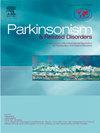Convergence insufficiency and Parkinson's disease progression
IF 3.1
3区 医学
Q2 CLINICAL NEUROLOGY
引用次数: 0
Abstract
Background
Parkinson's disease (PD) is a chronic, neurodegenerative disorder that significantly affects motor, sensory, and vision functions. Convergence insufficiency (CI) may be an indicator of PD progression. This study aimed to explore the relationship between CI and the stages of PD progression, as measured by the Hoehn and Yahr scale, and to compare the prevalence of CI and vision parameters between healthy individuals and PD patients.
Methods
Age-matched healthy controls (n = 97) and PD patients (n = 71) underwent medical history evaluations and vision assessments. Statistical analyses were conducted to compare CI prevalence across the Hoehn and Yahr stages between the control and PD groups. Binary logistic regression was used to evaluate the increase in CI prevalence as PD stages advanced.
Results
Significant differences in CI prevalence were noted between the control group (CG) and the PD group (PG), particularly in Stage III (p < .001) and overall (p < .001). The prevalence of CI increased with advancing PD stages (p < .001). In Stage I, CI emerged as the only significant factor, while Stages II and III revealed significant differences in multiple vergence-related parameters. Logistic regression revealed increased odds of CI correlating with advancing Hoehn and Yahr stages (p < .007).
Conclusion
A significant association was found between CI and PD progression. These findings underscore the importance of standardized assessment methods and the need for longitudinal research. Regular vision evaluations are essential for effectively managing CI and related vergence deficits in patients with PD.
求助全文
约1分钟内获得全文
求助全文
来源期刊

Parkinsonism & related disorders
医学-临床神经学
CiteScore
6.20
自引率
4.90%
发文量
292
审稿时长
39 days
期刊介绍:
Parkinsonism & Related Disorders publishes the results of basic and clinical research contributing to the understanding, diagnosis and treatment of all neurodegenerative syndromes in which Parkinsonism, Essential Tremor or related movement disorders may be a feature. Regular features will include: Review Articles, Point of View articles, Full-length Articles, Short Communications, Case Reports and Letter to the Editor.
 求助内容:
求助内容: 应助结果提醒方式:
应助结果提醒方式:


